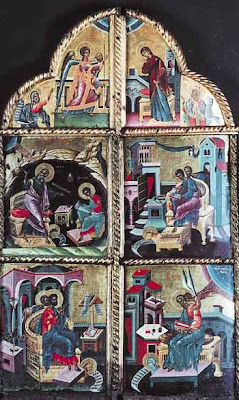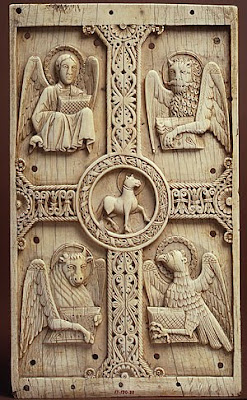
By Saint Sophronios of Jerusalem
These brief Lives are traditionally included in the introductory sections of the liturgical Gospels of the Orthodox Church in Greek and Church Slavonic. St Sophronius I was Patriarch of Jerusalem (634-638; feastday March 11) and as a patristic writer is also known as Sophronius the Sophist. His extant writings, including liturgical hymns, poetry, accounts of lives and miracles of the saints, and dogmatic works, have been published in Migne’s Patrologia Graeca. He is also co-author, with John Moshcus, of the Lemonarium, a classical collection of accounts of the ancient desert fathers.
The Life of the Evangelist Matthew
Matthew, also known as Levi, tax collector turned apostle, was the first to compose the Gospel of Christ, in Judea in the Hebrew language for those of the circumcision who believed. It is unknown by whom it was later translated into Greek. The Hebrew text is preserved to this day in the library of Caesarea that was most diligently assembled by the Martyr Pamphilus. The Nazarenes of Berroia in Syria, who use this text, gave me permission to copy it. From this, one is easily convinced that where the evangelist makes use of the testimony of the Old Testament Scriptures, either himself, or in the person of our Lord and Saviour Jesus Christ, he does not follow the authority of the Seventy (i.e. The Septuagint), but of the Hebrew text. It is from the latter that these two passages come: "Out of Egypt have I called My Son" (Mt 2:15) and "He shall be called a Nazarene" (Mt 2:23).
The Life of the Evangelist Mark
Mark was the disciple and interpreter of Peter, and, at the urging of the brethren in Rome, Mark wrote his short Gospel, following exactly what he had heard Peter tell. When Peter saw it, he gave it his approval, and directed that it be read in the Church, as Clement says in Book VI of his Outline. Papias, Bishop of Hierapolis, makes mention of this same Mark. Peter, in his first Epistle, refers to Rome metaphorically by the name “Babylon”: "The church that is at Babylon, chosen together with you, saluteth you; and so doth Mark my son" (I Pet. 5:13). Taking with him the Gospel which he himself had written, Mark went to Egypt, and was the first to preach Jesus Christ in Alexandria, where he established the Church. So highly did he excel both in teaching and in a life of steadfast endurance, that all those who came to believe in Christ, followed his example. And Philo [an Alexandrian Jewish philosopher of the first century AD], the most eloquent of the Jews, was so impressed when he saw the first church in Alexandria while it was still made up primarily of Jews, that he wrote a book about the life of those Christians, praising, as it were, his own race. Luke relates that the believers in Jerusalem held everything in common; likewise Philo preserved the memory of what he had seen occurring in Alexandria under the guidance of Mark. Mark reposed in the eighth year of Nero’s reign [63 A.D.]. He was buried in Alexandria, where Ananias succeeded him as bishop.
The Life of the Evangelist Luke
Luke, a physician of Antioch, was not unacquainted with Greek culture, as is shown by his writings. He was a companion of the Apostle Paul and followed him in all his journeys to foreign lands. Luke wrote the Gospel to which Paul himself refers when he says, "And we have sent with him the brother, whose praise is in the Gospel throughout all the churches" (II Cor. 8:18). And in his letter to the Colossians he says, "Luke, the beloved physician, greets you" (Col. 4:14). And to Timothy he says, "Only Luke is with me" (II Tim. 4:11).
Luke wrote another excellent book entitled The Acts of the Apostles, a history which ends with Paul’s two-year stay in Rome, that is, in the fourth year of Nero’s reign. This leads us to believe that The Acts of the Apostles was written in Rome. The tale of the journey of Paul and Thecla, and every other fable, such as the baptism of the lion, should not be counted among the canonical Scriptures. For it is not possible that he who was inseparable from the Apostle should not have known of this act among all his other acts. Tertullian also mentions a certain elder in Asia at that time, a companion of the Apostle Paul, who, when it was proven in the presence of John that he was the author of this book, confessed that he had written it out of love for Paul. Some say that this is why Luke does not mention himself as the author. Whenever Paul says in his own Epistles, "according to my Gospel" (Rom. 2:16, etc.), it is clear that he means the Gospel written by Luke. But Luke learned the Gospel not only from the Apostle Paul, who was not with the Lord in the body at that time, but from the other Apostles as well. He himself clearly states this at the beginning of his work, saying, even as they were handed down to us by those who from the beginning were eyewitnesses. Therefore he wrote the Gospel as he had heard it. But he wrote The Acts based on what he himself had experienced. Luke’s relics were taken up and carried to Constantinople, together with the relics of the Apostle Andrew, in the twentieth year of the reign of Constantius.
The Life of the Evangelist John
John, "the beloved disciple" [see Jn. 13:23], was the son of Zebedee and the brother of James, who was beheaded by Herod after the Passion of the Lord [see Acts 12:1-2]. John was the last of the Evangelists to write a Gospel. At the request of the bishops of Asia, he wrote his Gospel to combat the teachings of Cerinthus and other heretics, and especially the newly appeared doctrine of the Ebionites, who claimed that Christ did not exist until Mary gave birth to Him. This prompted John to expound on Christ’s divine generation. There is another reason why he wrote. After examining the Gospels of Matthew, Mark and Luke from beginning to end, John confirmed that they had recorded the truth [in contrast to authors of other, so-called gospels then in circulation]. Then he composed his own Gospel, focusing on the final year of the Lord’s earthly ministry and on His Passion. John omitted most of the events of the previous two years because these had already been faithfully recorded by Matthew, Mark and Luke. A careful study of the four Gospels will resolve the apparent discrepancies between John’s narrative and the narratives of the other three Evangelists. John also wrote an epistle, which begins, That which was from the beginning. This epistle is accepted as John’s by all ecclesiastical and scholarly authorities. The other two epistles bearing his name—the first, beginning, "The elder unto the elect lady"; and the second, "The elder unto the well-beloved Gaius"—are considered by some to be the work of a certain John the Elder, whose tomb (one of two bearing the name John) still exists in Ephesus to this day. Others, however, maintain that these two epistles are also the work of John the Evangelist. We will say more about this in the Life of Papias, the disciple of John. Now in the fourteenth year of his reign, the emperor Domitian initiated the second major persecution of Christians (Nero’s persecution was the first). John was banished to the island of Patmos and there wrote the Apocalypse, later translated by Justin Martyr and Irenaeus. After Dometian was murdered, his decrees were annulled by the Senate on account of their inhuman cruelty. Nerva ascended the throne, and John was allowed to return to Ephesus, where he lived until [101 AD, the fourth year of] Trajan’s reign. During this time, John founded and built up churches throughout Asia. In the sixty-eighth year after the Passion of the Lord, John reposed in great old age near Ephesus.
